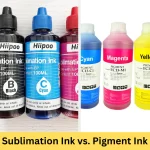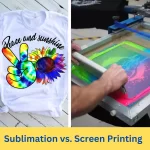In recent years, nylon fabrics have gained immense popularity in the sublimation industry because of their durability, strength, and moisture-wicking properties. From custom sportswear to personalized accessories and home decor, nylon offers a canvas of creative possibilities. But can you sublimate on nylon?
Yes, you can sublimate on nylon jackets, bags, and other products, but not all types of nylon are suitable for sublimation. There are certain things you need to know before sublimating nylon including heat press settings and sublimation ink.
Here, I’ll explain the complexities of sublimating on nylon from my personal experience, exploring the proper techniques and potential hurdles.
Read what materials you can sublimate.
Contents
- Can You Sublimate on Nylon?
- What Type of Nylon is Best for Sublimation?
- Can 100% Nylon Be Sublimated?
- Features of Nylon That Make It Great for Sublimation
- My Personal Guide to Sublimating on Nylon
- Nylon vs. Polyester for Sublimation – Which is Better?
- Can Nylon Withstand Heat Press?
- Final Words
- Frequently Asked Questions
Can You Sublimate on Nylon?
The answer is both – an exciting “yes” and a delicate “proceed with caution.” Sublimation on nylon is indeed possible, but it demands finesse. Nylon’s unique properties, such as its low heat resistance and potential for color bleeding, require careful consideration.
Sublimation on nylon material requires low temperature and pressure. I sublimated a design onto a nylon drawstring bag using a temperature of 375°F and a pressure of 40 psi (after meticulously adjusting the heat press settings), and the results were amazing. The colors were vibrant, and the image was clear and sharp.
What Type of Nylon is Best for Sublimation?
There are various types of nylon, the most common types for sublimation are nylon 6 and nylon 66.
Nylon 6: Also known as polyamide 6 or PA6, this type of nylon is widely used in sublimation printing. It is a thermoplastic polymer that is made from caprolactam. It is a strong and durable fabric that is also resistant to chemicals and abrasion.
Nylon 6 offers excellent color vibrancy and absorbs sublimation inks effectively, resulting in vibrant and long-lasting prints. It is known for its durability and resistance to wear, making it suitable for various applications like sportswear, outdoor gear, and promotional items.
Nylon 66: Also referred to as polyamide 66 or PA66, this type of nylon is another option for sublimation printing. It is also a thermoplastic polymer, but it is made from hexamethylenediamine and adipic acid. It is even stronger and more durable than nylon 6, but it is also more expensive.
While not as commonly used as Nylon 6, Nylon 66 also exhibits good sublimation qualities. It has high tensile strength and abrasion resistance, making it suitable for applications that require durability.
Both nylon 6 and nylon 66 are good for sublimation, but nylon 6 is generally considered to be the better option. This is because nylon 6 has a higher melting point, which means that it can withstand higher temperatures during the sublimation process.
Can 100% Nylon Be Sublimated?
Yes, you can sublimate on 100% nylon. However, there are a few things you need to know in order to get the best results.
One common misconception is that you need to use a special type of sublimation paper for 100% nylon. This is not true. You can use any type of sublimation paper, as long as it is compatible with your printer.
Another misconception is that you need to use a higher temperature when sublimating on 100% nylon. This is also not true. The temperature you use should be the same as the temperature you would use for any other type of fabric.
Many believe that pure nylon doesn’t absorb sublimation inks well, leading to faded or washed-out prints. But that’s not true either! Nylon is very good at absorbing sublimation dyes.
Features of Nylon That Make It Great for Sublimation
When it comes to sublimation printing, nylon fabrics offer a range of unique properties that make them a perfect canvas for vibrant and long-lasting prints. Here’s why nylon stands out as an excellent choice:
1. Durability
One of the best things about sublimating on nylon is that the prints are very durable. Nylon is a strong fabric and has robust nature, which can withstand a lot of wear and tear.
This durability ensures that sublimation prints on nylon remain vibrant and intact, even with frequent use and washing. Whether it’s sportswear, bags, or outdoor gear, nylon’s durability ensures your sublimated designs maintain their brilliance over time, even in high-wear conditions.
2. Moisture Resistance
Another great thing about sublimating on nylon is that the prints are moisture-resistant. This means that they will not fade or crack if they get wet. Unlike other materials, nylon fabrics are less likely to fade or bleed when exposed to moisture or sweat.
This great feature makes nylon garments an ideal choice for water sportswear and activewear, ensuring that your designs stay vibrant during intense physical activities.
3. Color Vibrancy
The colors of sublimated prints on nylon are also very vibrant. This is because its smooth surface allows sublimation inks to penetrate deeply, resulting in stunningly vibrant and sharp designs that remain brilliant even after repeated washes.
Getting dull results? Learn how to make sublimation brighter.
4. Stretch and Flexibility
Many nylon fabrics, such as nylon-spandex blends, offer excellent stretch and flexibility. This property is especially beneficial for sublimated sportswear, as it ensures comfort and unrestricted movement during physical activities.
5. Lightweight and Breathable
Nylon’s lightweight and breathable nature make it a preferred choice for sublimating on apparel items. Whether it’s jerseys, leggings, or t-shirts, the breathability of nylon ensures comfort for the wearer in various climates.
6. Versatility
From fashion apparel and accessories to promotional items like banners and flags, nylon’s adaptability opens up a wide range of creative possibilities. It is equally adept at sublimation printing on accessories, home textiles, and promotional merchandise, offering endless opportunities for creative expression.
7. Wrinkle Resistance
Nylon’s natural wrinkle resistance minimizes the risk of unsightly creases or distortions in sublimated designs. This feature ensures a smooth and polished appearance, making it an excellent choice for sublimated apparel.
My Personal Guide to Sublimating on Nylon
I remember the excitement when I first tried sublimating on nylon fabric. The process was surprisingly straightforward, and the results were simply mesmerizing! Here’s how I achieved beautiful sublimation prints on nylon:
Gathering the Supplies
Before diving in, I made sure to have all the following necessary supplies ready:
- A sublimation printer
- Sublimation paper
- A heat press
- High-quality sublimation ink
- Nylon fabric
- Butcher paper
- Heat resistant tape
Step 1: Choosing the Perfect Design
Select a design that will complement the characteristics of nylon. Nylon is a strong, durable fabric, so I like to choose designs that are also strong and durable.
I carefully selected a vibrant and intricate pattern that complemented the nylon’s smooth surface. I wanted to take full advantage of the fabric’s unique properties.
Step 2: Printing with Precision
To print the design on sublimation paper for nylon sublimation, you will need to follow the instructions that come with your sublimation printer. I use Epson EcoTank 2860, you can check the Epson printer settings for sublimation.
The printer heats up the ink and transfers it to the sublimation paper. Once the design is printed, I let it dry completely. After that, I pay close attention to getting the right size and alignment to match the dimensions of my nylon fabric accurately.
Step 3: Preparing the Heat Press
To prepare the heat press for nylon sublimation, you will need to preheat the heat press to the correct temperature. The correct temperature for sublimation on nylon will vary depending on the type and thickness of nylon fabric you are using.
I preheat the heat press to the correct temperature, which is usually around 375°F degrees.
Step 4: Prepare the Nylon for Sublimation
Before applying the design, I made sure my nylon fabric was clean and wrinkle-free. Once everything was set, I positioned the sublimation paper carefully on the fabric and secure it using heat-resistant tape – ensuring it was centered perfectly.
Step 5: Applying the Heat
Now it’s time to do the magic. Set your heat press temperature to 375°F and timer at 50 seconds. With a layer of protective paper on top of the sublimation paper and fabric, close and press the heat press machine.
Step 6: Revealing the Final Print
As the heat press process was completed, I carefully removed the sublimation paper, revealing my creation. The colors were vibrant and the details crisp – pure satisfaction!
Step 7: Sealing the Design
I let the print cool completely, and then I place it in an oven at a low temperature for 15 seconds of time. This step locked the ink onto the fabric, making it more durable and resilient to wear and washing.
Nylon vs. Polyester for Sublimation – Which is Better?
Nylon and polyester are both synthetic fabrics that are often used for sublimation printing. However, there are some key differences between the two fabrics that make nylon a better choice for sublimation.
Color retention: Nylon is better at retaining its color than polyester. This is because the dye molecules in nylon are smaller and more evenly distributed throughout the fabric. As a result, the colors in sublimated nylon prints are more vibrant and long-lasting.
Print longevity: Nylon is also better at holding up to repeated washings than polyester. This is because nylon is a stronger and more durable fabric. As a result, sublimated nylon prints are less likely to fade or crack over time.
Can Nylon Withstand Heat Press?
Yes, nylon can withstand a heat press. However, it is crucial to use the correct temperature and pressure to avoid damaging the fabric.
The melting point of nylon is around 215°C (419°F), so set the heat press to a temperature that is below this. A good starting point is 375°F. Excessive heat or incorrect settings on the heat press can cause the fabric to melt or warp, ruining your sublimation project.
If you are still confused or not confident enough to heat-press nylon fabric, you can try other techniques such as putting vinyl on nylon or screen printing. If not sublimation, then I prefer screen printing on nylon bomber jackets, t-shirts, tights, and other garments as a second option. It is the safest technique, however, it requires a little more hassle than sublimation.
Final Words
So, the truth about sublimating on nylon is crystal clear: yes, you can sublimate on nylon! This versatile fabric’s exceptional durability and moisture resistance properties make it an ideal canvas for vibrant and enduring sublimation prints.
We’ve also debunked misconceptions, offered valuable insights, and provided a step-by-step guide to achieving successful sublimation results on this versatile fabric. With proper techniques and the right sublimation ink, nylon reveals its potential as a top-notch choice for various creative projects
Now, armed with knowledge and inspiration, it’s time for you to explore the endless possibilities of sublimating on nylon.
Frequently Asked Questions
Can you sublimate on nylon tights?
Yes, you can sublimate on nylon tights! Nylon tights are a popular clothing item among fitness and yoga loving women, and sublimation allows you to add unique and vibrant designs to them.
Can you heat press on 100% nylon?
Yes, you can heat press on 100% nylon fabrics. However, it’s essential to consider the fabric’s heat resistance. To prevent damage, use lower heat press temperatures and shorter pressing times compared to other materials. Test a small sample first to find the right balance for successful sublimation on 100% nylon fabrics.
Can I use a regular heat press for sublimating on nylon?
Yes, a regular heat press can be used for sublimation on nylon, but there are some considerations. Nylon’s sensitivity to heat requires precise temperature control. Ensure your heat press allows for accurate temperature adjustment within the recommended range for nylon sublimation.
Can I sublimate dark colors on nylon fabric?
Sublimating dark colors on nylon can be challenging due to the nature of the sublimation process. Sublimation relies on the dye-sublimation ink turning into a gas and bonding with the fabric’s fibers. On dark-colored nylon fabrics, the sublimation ink may not show up as vividly as it does on light-colored fabrics.
To achieve better results, we advise using light-colored nylon fabrics for sublimation printing. If you must sublimate on dark nylon, consider using a white base layer before applying the design to enhance color vibrancy.
- 5 Best 13×19 Sublimation Printer for Wide Format Substrates - December 27, 2023
- Best 11×17 Sublimation Printer to Print Tabloid Size Paper - December 26, 2023
- Epson ET-8550 vs ET-15000: Best Wide-Format EcoTank Printer - December 25, 2023







